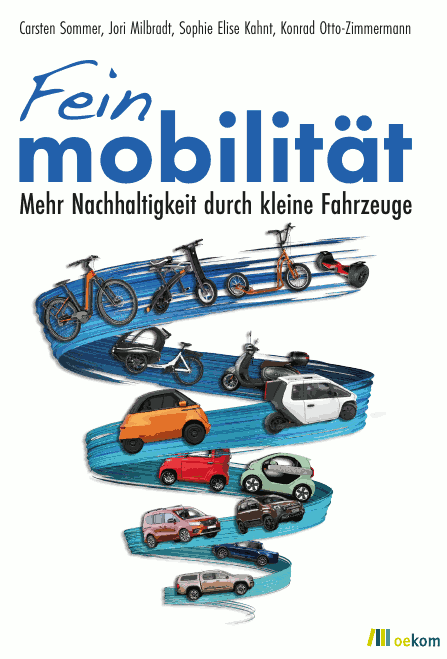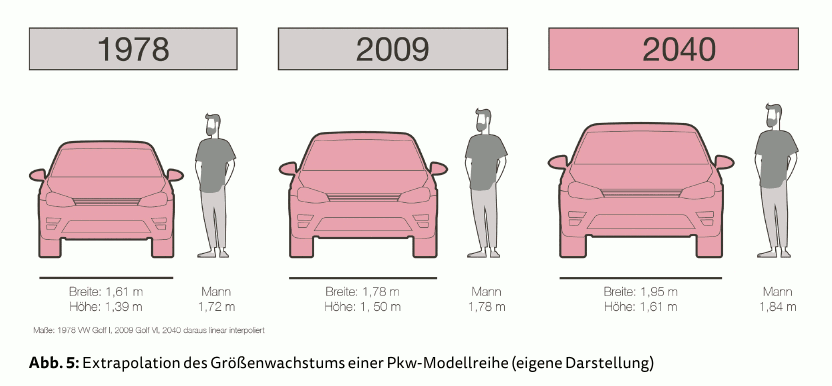
Contents | About | Contact
article 35, issue 15
Text: Andreas Pooch - figures: oekom
December 21, 2024
Editor's Note
This review of the new German language book Feinmobilität was first published in the Swiss-German publication Info Bull 240 (hpv.org and futurebike.ch) and is reproduced and translated here. Because of many clear drawings, photos and numbers, the book is worthwhile of attention also by non-German readers, especially as private translation software is available today. In addition, 91 vehicles from e-skateboards to small e-trucks are pictured with dimensions and links (clickable in the e-book). Unassisted bicycles and HPVs are covered with respect to data, but not pictured or described. Fine mobility on water, ice or snow is not covered at all.

Everyone makes use of and is influenced, sometimes even harmed, by: mobility. Today general understanding of mobility is shaped by the car. Industry tells us that it gives us freedom and that without this machine we would no longer be able to cope with life. This has become ingrained in our language.
A turnaround in mobility is urgently needed because of traffic violence, the climate, public health and many other reasons. Even if we want to free ourselves from the dominance of the car, we are still guided by its normality. No matter what the issue, the car remains the benchmark in most societies.
A mobility transition is far more complex than just the transition away from the combustion engine towards electric drive. This book published by oekom shows what is actually involved, using the term Feinmobilität, or Fine Mobility in English. (Terms such as Lean Mobility or Micromobility have been used, however usually only in the context of small electric cars. Fine Mobility aims to cover human powered mobility as well, starting at the minimum: walking, skating, etc. Ed.)
An interdisciplinary team of authors has presented this 200-page book on the comprehensive introduction and classification of fine mobility. It is about sustainable mobility, about transport adapted to the respective purpose of use, about resource-saving means of transporting passengers and freight. The book is aimed at urban and transport planners, road traffic authorities, scientists and associations. They all need to know how adapted mobility works that protects the urban living space.
The book is divided into eight chapters that illuminate and structure all aspects of the new term "fine mobility". An extensive appendix with references rounds off the work and demonstrates the scientific approach of the project. And yet the work is also easy to read for laypeople not belonging to the target group who want to take a closer look at sustainable transport choices.
First of all, the term is discussed, what is included in fine mobility and why the term was created in the first place. The steady increase in the physical volume of cars since the 1970s is examined and it is shown why this is so harmful for our cities and for our children. It is shown that the "mobility transition" is only one aspect of a transport transition. The other ones are the "dimension transition" (from coarse to fine mobility), the drive transition (towards environmentally friendly drives), the "use transition" (vehicle and trip sharing) and the "transportation method transition" (from private cars to shared vehicles).
The second chapter deals with the size classification of transportation means. What effect does the size of the vehicle have? (E.g. fig. 5 shows that the size of cars continues to increase faster than that of humans. Ed.) Existing vehicle classifications are explained and what needs to change and why.

The third chapter describes in detail the vehicle world of fine mobility, how it is already available on the transport market today and which startups have which ideas for alternatives to the classic automobile. To do this, various possible typologies are first presented in order to bring a certain order to the vehicle world. The classification preferred by this book is based on size class (XXS, XS, S) which first shows examples of the vehicles that belong in each category. However, one can also classify vehicles according to common vehicle groups (walking aids, pedestrian supplements, wheelchairs, bicycles, micromobiles, light electric vehicles, electric minicars). This contrasts with categorization according to current legal regulations (motorized wheelchair, bicycle, small electric vehicle, light motor vehicle, motor vehicle). Small vehicles can also be classified according to speeds in vehicle registration regulations (up to 15, up to 25, up to 45 km/h, unlimited). The International Transport Forum at the OECD has defined six vehicle families (walking, vehicles for standing and sitting on, lightly motorized vehicles, car-like vehicles, truck-like vehicles, tram-like vehicles). Then there is the vehicle typology according to LEVI (Light Electric Vehicle Innovation Cluster) and a LEV categorization by the DLR (German Aerospace Center). Finally, a classification according to industry sectors is possible, i.e. according to the manufacturer or trade sector from which the respective vehicle comes.
The market for fine vehicles is extremely fragmented in terms of manufacturer and trade sectors, sales structures, industrial, trade and user associations as well as trade and consumer fairs. The industry classification of the Federal Statistical Office reflects this fragmentation. The product range of fine vehicles cannot be identified from this.
Chapter 3 concludes with a collection of extensive profiles of fine vehicles, including some recumbent assisted HPVs like the Podbike Frikar Signature and the Eurocircuits Quadvelo. Unfortunately, standard and recumbent cycles without fairings are missing here.
Chapter 4 examines the potential of fine mobility. First of all, it looks at the figures for what is already being used, then it moves on to the acceptance of these vehicles and examines how this can be improved for each vehicle class. Usage patterns are examined and how car use can be replaced by more suitable vehicles depending on the purpose. This is illustrated using typical groups of people (individuals, families, sharing communities). Finally, the substitution potential is examined and how it can be more easily realized.
Chapter 5 examines in detail the effects of mobility and what positive changes occur when switching to fine mobility. It goes into great detail in order to better understand the effects. And fine mobility also requires a suitable infrastructure, which does not yet exist or only to a very limited extent, at least in Germany. The complexity of trying to make changes here is enormous and is due to the numerous legal hurdles that continue to favor the car at the expense of other forms of transport. There is simply not the political will to change this significantly.
The book is not intended to make demands on individual players, but merely to introduce the concept of “fine mobility”. Nevertheless, the final chapter presents a wide range of fields of action and players in the mobility sector that could pave the way for finer mobility.
Authors: Carsten Sommer, Jori Milbradt, Sophie Elise Kahnt, Konrad Otto-Zimmermann
Title: Feinmobilität - Mehr Nachhaltigkeit durch kleine Fahrzeuge (German language)
ISBN: 978-3-98726-098-8
Hardcover, 200 pages
Publication date: 01.10.2024
DOI: https://doi.org/10.14512/9783987263385
Creative Commons license type: CC BY-NC-ND 4.0 (Open Access)